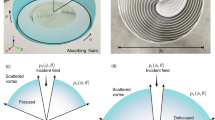Abstract
THE amplitude of vibrations on the wave surface of a spherical light wave may, or may not, be homogeneous. According to the classical electromagnetic theory of light, for a spherical wave emitted by a linear oscillator, the intensity is at a maximum in the direction perpendicular to the axis of the oscillator, and at a minimum in the direction of prolongation of the axis.
This is a preview of subscription content, access via your institution
Access options
Subscribe to this journal
Receive 51 print issues and online access
$199.00 per year
only $3.90 per issue
Buy this article
- Purchase on Springer Link
- Instant access to full article PDF
Prices may be subject to local taxes which are calculated during checkout
Similar content being viewed by others
Author information
Authors and Affiliations
Rights and permissions
About this article
Cite this article
SKOMTAO, S., SU, L. Anisotropy of Spherical Sound Waves. Nature 133, 214–215 (1934). https://doi.org/10.1038/133214a0
Issue Date:
DOI: https://doi.org/10.1038/133214a0
Comments
By submitting a comment you agree to abide by our Terms and Community Guidelines. If you find something abusive or that does not comply with our terms or guidelines please flag it as inappropriate.



